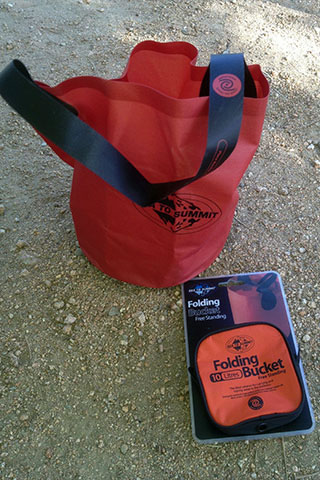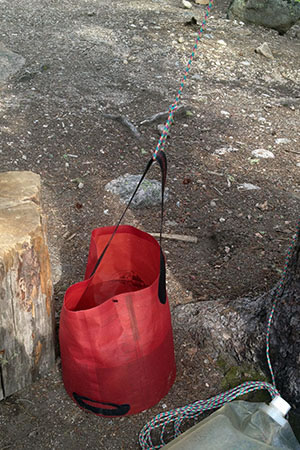| 861 | Sea to Summit Folding Bucket - 10 Liters |
2013-09-25 |

During the summer of 2013, we stayed two nights at Lawn Lake in Rocky Mountain National Park. The backcountry sites were great, but they were a good distance from Lawn Lake, our water source. We had limited means for transporting water and so instead of making countless trips to the lake, we moved our kitchen closer to the lake for the evening meals. We still had to make many short trips to the lake to fill our small containers for cooking and water for clean-up.
As we sat on the broad shore of the lake, Amy suggested that we get a "bucket" that she had seen at REI to help with the water storage. Hmm ... I wasn't sure.
We first shopped for the bucket in Estes Park, but did not have any luck. The bucket did however make it on the shopping list and on our next visit to town, Boulder, we stopped at the REI. They stocked the Sea to Summit Folding Bucket - 10 Liters and also the 20 Liters version. I was still skeptical, but Amy thought it would really make water collection much easier.
Well, Amy was right, the bucket was a worthy investment. In fact so much so, that by the end of the summer, we had two buckets!
A few Folding Bucket notes ...
The bucket weighs 2.7 ounces on our scales (or listed as 2.8 ounces at REI). We did not include the small storage case in the weight.
8.5 liters is probably the most water the bucket could contain and be carried anywhere. 10 liters is to the lip.
One 10 liter bucket weighed more than two of the 2.1L Platypus bottles (1.3 oz each). Of course 10 liters (though realistically 8.5L) is more than 4.2 liters.
The bucket is made of a plastic coated nylon. It is a very interesting material. It seems as if it would make a great tent floor, especially on a car camping tent.
The bucket folds to a relatively compact size.
To aid in pouring, the bucket has a small handle near the bottom.
We carried the bucket to the water source, filled it, and returned to camp.
Water running over a lip was the easiest source for filling the bucket. The rim of the bucket is flexible and tends to close when dipping it. We filled the bucket in stages. On the first dip we would fill it partially, the water in the bucket would help hold the bucket open for the next dip, and so on. Filling the bucket with the three dip method, still only took seconds.

Small cord provides tension on the handles
Returning to camp with a full bucket of water we placed it on a relatively flat spot. If the bucket was over half full, it had a tendency to collapse after standing untouched for some time. To solve the collapsing problem, we rigged the handle so that it had upward tension. A string tied above the bucket works well, but we also used a stick through the handle. The trick is to provide a bit of tension on the handles.
The bucket could also be hoisted to hang free, but we never tried it.
Once in camp, we filled our cooking pot with the water from the bucket. We did not need to filter the water we were planning on boiling. For our drinking water, we filtered the water from the bucket while sitting in camp.
We never stored the bucket in the provided small container.
We did use the container to store our dish cleaning supplies (scrubber, scrapper, scent free biodegradable soap, etc). These supplies were used while car camping.
We eventually bought a second bucket. One was used for collecting water to treat (dirty water) and the other was used for clean water or to fill from a water spigot.

Downed limb rigged to provide tension on the handle
Amy was right, the bucket was a nice addition to our camp kitchen. We used it in the backcountry and around the campgrounds.
Happy Folding Bucket trails